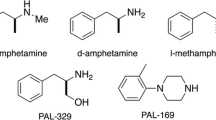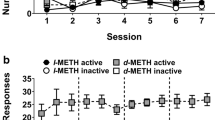Abstract
Cocaine self-administration was compared with responding maintained by the dopamine D3 agonist 7-hydroxy-N,N-di-n-propyl-2-aminotetralin (7-OH-DPAT) in rhesus monkeys. In the first experiment, monkeys (n=3) with an extensive cocaine history responded under a fixed-interval (FI) 5-min schedule of IV cocaine (0.03 mg/kg per injection) presentation, during daily 4-h sessions. When responding was stable, dose-response curves were determined for cocaine (0.01-0.3 mg/kg per injection) and 7-OH-DPAT (0,001–0.1 mg/kg per injection); each dose was available for at least five consecutive sessions. When substituted for the baseline dose of cocaine, other doses of cocaine and 7-OH-DPAT maintained rates higher than responding maintained by saline injections, in all monkeys. 7-OH-DPAT maintained response rates equal to or higher than rates of cocainemaintained responding in all monkeys. In a second experiment, acquisition of 7-OH-DPAT self-administration was evaluated in a group of cocaine-navie monkeys (n=3). Various doses of 7-OH-DPAT (0.003–0.03 mg/kg during daily 4-h sessions. After 10–13 sessions, 7-OH-DPAT self-administration could not be trained in any cocaine-naive monkey. When cocaine was made available to these monkeys, responding was reliably maintained within one to four sessions and the schedule was gradually increased to FI 5-min. After stable responding under an FI 5-min schedule of 0.03 mg/kg per injection cocaine presentation, 7-OH-DPAT (0.01 mg/kg per injection) was again made available to two of the monkeys, and maintained responding at rates higher than saline. To determine better whether a history of responding maintained by another reinforcer would result in high rates of 7-OH-DPAT self-administration, two cocaine-naive monkeys were trained to respond under an FI 5-min schedule of food presentation. Substituting 7-OH-DOAT (0.003–0.03 mg/kg per injection) for food resulted in very low rates of responding. Taken together, these results suggest that despite comparable reinforcing effects in cocaine-substitution studies, 7-OH-DPAT and cocaine differ in their rate of acquisition, perhaps indicating a lower abuse liability for 7-OH-DPAT.
Similar content being viewed by others
References
Beitner-Johnson D, Guitart X, Nestler EJ (1992) Neurofilament proteins and the mesolimbic dopamine system: common regulation by chronic morphine and chronic cocaine in the rat ventral tegmental area. J Neurosci 12: 2165–2176
Berger B, Gaspar, P, Verney C (1991) Dopaminergic innervation of the cerebral cortex: unexpected differences between rodents and primates. Trends Neurosci 14: 21–27
Caine SB, Koob GF (1993) Modulation of cocaine self-administration in the rat through D-3 dopamine receptors. Science 260: 1814–1816
Caine SB, Koob GF (1995) Pretreatment with the dopamine agonist 7-OH-DPAT shifts the cocaine self-administration dose-effect function to the left under different schedules in the rat. Behav Pharmacol 6: 333–347
Catania AC, Reynolds GS (1968) A quantitative analysis of the responding maintained by interval schedules of reinforcement. J Exp Anal Behav 11: 327–383
Goeders N, Smith JE (1983) Cortical dopaminergic involvement in cocaine reinforcement. Science 221: 773–775
Griffiths RR, Bigelow GE, Henningfield JE (1980) Similarities in animal and human drug-taking behavior. In: Mello NK (ed) Advances in substance abuse, vol 1. JAI Press, Greenwich, Conn., pp 1–90
Hurd YL, Weiss F, Koob GF, And N-E, Ungerstedt U (1989) Cocaine reinforcement and extracellular dopamine overflow in rat nucleus accumbens: an in vivo microdialysis study. Brain Res 498: 199–203
Johanson CE (1978) Drugs as reinforcers. In: Blackman DE, Sanger DJ (eds) Contemporary research in behavioral pharmacology. Plenum, New York, pp 325–390
Johanson CE, Balster, RL, Bonese K (1976) Self-administration of psychomotor stimulant drugs: the effects of unlimited access. Pharmacol Biochem Behav 4: 45–51
Katz JL, Ricaurte GA, Witkin JM (1992) Reinforcing effects of enantiomers ofN,N-dimethylamphetamine in squirrel monkeys. Psychopharmacology 107: 315–318
Lamb RJ, Griffiths RR (1990) Self-administration in baboons and the discriminative stimulus effects in rats of bupropion, nomifensine, diclofensine and imipramine. Psychopharmacology 102: 183–190
Nader MA, Bowen CA (1995) The effects of different food-reinforcement histories on cocaine self-administration by rhesus monkeys. Psychopharmacology 118: 287–294
Nader MA, Reboussin DM (1994) The effects of behavioral history on cocaine self-administration in rhesus monkeys. Psychopharmacology 115: 53–58
Ritz MC, Lamb RJ, Goldberg SR, Kuhar MJ (1987) Cocaine receptors on dopamine transporters are related to self-administration of cocaine. Science 237: 1219–1223
Self DW, Stein L (1992) The D1 agonists SKF 82958 and SKF 77434 are self-administered by rats. Brain Res 582: 349–352
Sokoloff P, Giros B, Martres M-P, Bouthenet M-L, Schwartz J-C (1990) Molecular cloning and characterization of a novel dopamine receptor (D3) as a target for neuroleptics. Nature 347: 146–151
Spealman RD, Keehler RT (1981) Self-administration of cocaine derivatives by squirrel moneys. J Pharmacol Exp Ther 216: 532–536
Weed MR, Vanover KE, Woolverton WL (1993) Reinforcing effect of the D1 dopamine agonist SKF 81297 in rhesus monkeys. Psychopharmacology 113: 51–52
Wilson MC, Schuster CR (1972) The effects of chlorpromazine on psychomotor stimulant self-administration in the rhesus monkey. Psychopharmacologia 26: 115–126
Winger G, Woods JH (1973) The reinforcing property of ethanol in the rhesus monkey: I. Initiation, maintenance and termination of intravenous ethanol-reinforced responding. Ann NY Acad Sci 215: 162–175
Wise RA (1980) Action of drugs of abuse on brain reward systems. Pharmacol Biochem Behav 13: 213–223
Woods JH, Ikomi F, Winger G (1971) The reinforcing property of ethanol. In: Roach MK, McIsaac WM, Creaven PJ (eds) The biological aspects of alcohol. University of Texas Press, Austin, Texas, pp 371–388
Woolverton WL, Johnson KM (1992) Neurobiology of cocaine abuse. Trends Pharmacol Sci 13: 193–200
Woolverton WL, Nader MA (1990) Experimental evaluation of the reinforcing effects of drugs. In: Adler MW, Cowan A (eds) Testing and evaluation of drugs of abuse. Wiley-Liss, New York, pp 165–192
Woolverton WL, Goldberg LI, Ginos JZ (1984) Intravenous self-administration of dopamine receptor agonists by rhesus monkeys. J Pharmacol Exp Ther 230: 678–683
Yokel RA, Wise RA (1978) Amphetamine-type reinforcement by dopamine agonists in the rat. Psychopharmacology 58: 289–296
Author information
Authors and Affiliations
Rights and permissions
About this article
Cite this article
Nader, M.A., Mach, R.H. Self-administration of the dopamine D3 agonist 7-OH-DPAT in rhesus monkeys is modified by prior cocaine exposure. Psychopharmacology 125, 13–22 (1996). https://doi.org/10.1007/BF02247388
Received:
Revised:
Issue Date:
DOI: https://doi.org/10.1007/BF02247388




